![]()
![]()
![]()
Use LEFT and RIGHT arrow keys to navigate between flashcards;
Use UP and DOWN arrow keys to flip the card;
H to show hint;
A reads text to speech;
9 Cards in this Set
- Front
- Back
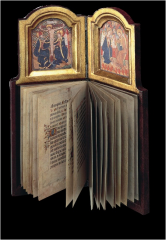
|
Diptych and Prayer Book of Philip the Good. Flemish, ca. 1450
Many noblemen collected Books of Hours during the 15th century as symbols of status. Phillip the Good is said to have collected as many as 600 manuscripts by the end of his life. This particular one combines a painting diptych with a prayer book and is a show of how illuminated manuscripts influenced paintings. |
|
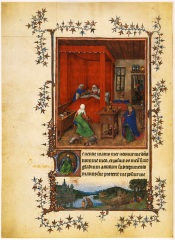
|
Turin-Milan Hours. Jan van Eyck. Flemish, first half of the fifteenth century.
This particular book has a complex history and was considered lost until found in a Belgian antique shop. It was created for Jean Duc de Berry and illuminated Jan Van Eyck & others. The style of the time had developed with detail, receding space and techniques evident in Van Eyck's Arnolfini painting. |
|
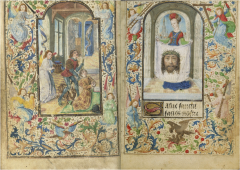
|
Prayer Book of Charles the Bold. Lieven van Lathem. Flemish, Ghent and Antwerp, 1469 and ca. 1471.
Depicts Charles the Bold kneeling before his prayer book along with St. George and an Angel; opposite is St. Veronica. The book itself is only 2 inches high, showing the skill needed to paint at different scales. Distance and atmospheric perspective is evident. |
|
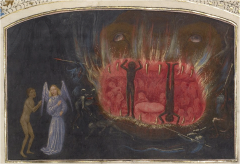
|
Visions of Knight Tondal. Simon Marmion. Flemish and French, ca. 1470.
Illustrates the story of the sinful knight Tondal who is shown visions of Hell during a near-death experience. In this image, Tondal and his guardian angel (painted in light) look into the maw of hell being held up by eternally damned souls. The flames, tongue and eyes are all painted realistically. The book shows different punishments for sinners like the hell of unchaste priests and nuns getting gobbled up by a dragon, excreted into a lake of ice, and impregnated with iron-beaked serpents that eat them alive to start it all over. Images of Hell during this time were more interesting and intriguing to the populace than images of Heaven. |
|
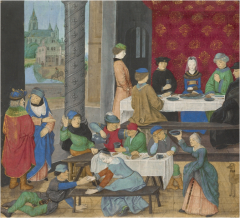
|
Cutting from Valerius Maximus, Fais et ditsmemorables des romains. Master of the Dresden Prayer Book. Flemish, ca. 1475-80.
Depicts a story of how women should be temperate by comparing a civil table with a table of unruly, unchaste drunkards. |
|
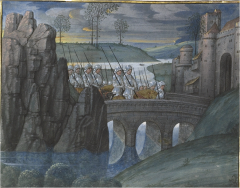
|
Jean Froissart, Chronicles. Master of the Getty Froissart. Bruges, about 1480.
Comes from one of the first texts where the historian traveled around and got firsthand accounts of the Hundred Years War. It was likely made for Edward IV of England but never completed. Books of this type were expensive to make as the amount of animal skin it took to create the pages was staggering. The detail in the scene includes a realistic depiction of clear water as well as light reflected in water and clouds. |
|
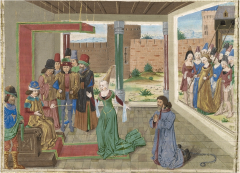
|
Quintus Curtius Rufus, Livre des fais d’Alexandre le grant. Master of the Jardin de vertueuse consolation. Bruges, about 1470-75.
Illustration comes from a large book about Alexander the Great, albeit with some edits (his favorite eunuch is depicted as a woman). These kinds of historical books were carried into war to inspire soldiers. The original dedication inscription is edited out with gold. |
|
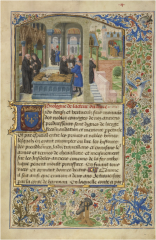
|
Roman de Gillion de Trazegnies. Lieven van Lathem. Antwerp, after 1464.
Depicts illustrations of a romance story (despite it being an unpopular genre at the time). The first image sets up the story of the author hearing the story from monks. There is detail shown of gossiping monks, all with distinct faces, and there is an illusion given of looking right into the walls (missing pillar) to play with interior and exterior. The book has images inside the first letters of some paragraphs, showing amazing detail in such small scale. The story is of a man who inadvertedly becomes a bigamist when, thinking his wife back home died during childbirth, marries the daughter of a sultan while on pilgrimage to the Holy Land. However after he finds out his first wife is still alive, the two wives meet and get along to eventually retire in a convent. The knight fights battles til he dies and is eventually buried between his two wives. |
|
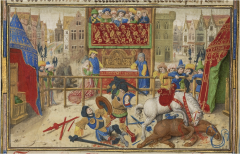
|
Roman de Gillion de Trazegnies. Lieven van Lathem. Antwerp, after 1464.
Though both the author never went to the holy land, they make the art look exotic but familiar (Bruges architecture in the background but with tents and turbans, motifs of the East. Battle scenes have camels, elephants and dark-skinned people). As the knights fight, so are their horses. These events are even echoed in marginalia. |

